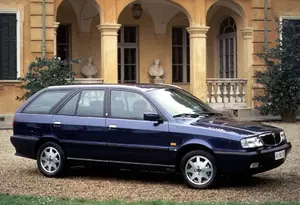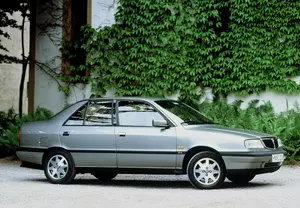
| Vehicle | Curb weight | Difference from world's smallest | Weight to power ratio | 0—60 mph acceleration ratio | Consumption ratio |
|---|---|---|---|---|---|
| 1.6 |
1180 kg / 2602 lbs |
755 kg (1665 lbs) heavier | 13 kg to 1 hp | 94 kg/s (207 lbs/s) |
149 kg/L (329 lbs/L) |
| 1.8 GT 16V |
1350 kg / 2977 lbs |
925 kg (2040 lbs) heavier | 10 kg to 1 hp | 136 kg/s (300 lbs/s) |
161 kg/L (355 lbs/L) |
| 1.8 LE |
1350 kg / 2977 lbs |
925 kg (2040 lbs) heavier | 12 kg to 1 hp | 134 kg/s (295 lbs/s) |
173 kg/L (381 lbs/L) |
| 1.8 |
1255 kg / 2767 lbs |
830 kg (1830 lbs) heavier | 12 kg to 1 hp | 165 kg/s (364 lbs/s) |
157 kg/L (346 lbs/L) |
| 2.0 16V |
1300 kg / 2867 lbs |
875 kg (1930 lbs) heavier | 9 kg to 1 hp | 137 kg/s (302 lbs/s) |
146 kg/L (322 lbs/L) |
| 2.0 16V 4X4 |
1395 kg / 3076 lbs |
970 kg (2139 lbs) heavier | 10 kg to 1 hp | 142 kg/s (313 lbs/s) |
140 kg/L (309 lbs/L) |
| Vehicle | 1.6 |
|---|---|
| Curb weight |
1180 kg / 2602 lbs |
| Difference from world's smallest | 755 kg (755 lbs) heavier |
| Weight to power ratio | 13 kg to 1 hp |
| 0—60 mph acceleration ratio | 94 kg/s (207 lbs/s) |
| Consumption ratio |
149 kg/L (329 lbs/L) |
| Vehicle | 1.8 GT 16V |
| Curb weight |
1350 kg / 2977 lbs |
| Difference from world's smallest | 925 kg (925 lbs) heavier |
| Weight to power ratio | 10 kg to 1 hp |
| 0—60 mph acceleration ratio | 136 kg/s (300 lbs/s) |
| Consumption ratio |
161 kg/L (355 lbs/L) |
| Vehicle | 1.8 LE |
| Curb weight |
1350 kg / 2977 lbs |
| Difference from world's smallest | 925 kg (925 lbs) heavier |
| Weight to power ratio | 12 kg to 1 hp |
| 0—60 mph acceleration ratio | 134 kg/s (295 lbs/s) |
| Consumption ratio |
173 kg/L (381 lbs/L) |
| Vehicle | 1.8 |
| Curb weight |
1255 kg / 2767 lbs |
| Difference from world's smallest | 830 kg (830 lbs) heavier |
| Weight to power ratio | 12 kg to 1 hp |
| 0—60 mph acceleration ratio | 165 kg/s (364 lbs/s) |
| Consumption ratio |
157 kg/L (346 lbs/L) |
| Vehicle | 2.0 16V |
| Curb weight |
1300 kg / 2867 lbs |
| Difference from world's smallest | 875 kg (875 lbs) heavier |
| Weight to power ratio | 9 kg to 1 hp |
| 0—60 mph acceleration ratio | 137 kg/s (302 lbs/s) |
| Consumption ratio |
146 kg/L (322 lbs/L) |
| Vehicle | 2.0 16V 4X4 |
| Curb weight |
1395 kg / 3076 lbs |
| Difference from world's smallest | 970 kg (970 lbs) heavier |
| Weight to power ratio | 10 kg to 1 hp |
| 0—60 mph acceleration ratio | 142 kg/s (313 lbs/s) |
| Consumption ratio |
140 kg/L (309 lbs/L) |

| Vehicle | Curb weight | Difference from world's smallest | Weight to power ratio | 0—60 mph acceleration ratio | Consumption ratio |
|---|---|---|---|---|---|
| 2.0 i.e. |
1218 kg / 2686 lbs |
793 kg (1749 lbs) heavier | 11 kg to 1 hp | 118 kg/s (260 lbs/s) |
137 kg/L (302 lbs/L) |
| 1.6 i.e. |
1100 kg / 2426 lbs |
675 kg (1489 lbs) heavier | 14 kg to 1 hp | - | - |
| 1.6 LE |
1060 kg / 2337 lbs |
635 kg (1400 lbs) heavier | 12 kg to 1 hp | 92 kg/s (203 lbs/s) |
145 kg/L (320 lbs/L) |
| 1.8 i.e. |
1215 kg / 2679 lbs |
790 kg (1742 lbs) heavier | 12 kg to 1 hp | 102 kg/s (225 lbs/s) |
154 kg/L (340 lbs/L) |
| 1.8 GT 16V |
1310 kg / 2889 lbs |
885 kg (1952 lbs) heavier | 10 kg to 1 hp | 138 kg/s (304 lbs/s) |
156 kg/L (344 lbs/L) |
| 1.8 LE |
1310 kg / 2889 lbs |
885 kg (1952 lbs) heavier | 12 kg to 1 hp | 134 kg/s (295 lbs/s) |
172 kg/L (379 lbs/L) |
| 1.8 i.e. LE |
1173 kg / 2586 lbs |
748 kg (1649 lbs) heavier | 13 kg to 1 hp | 98 kg/s (216 lbs/s) |
138 kg/L (304 lbs/L) |
| 1.9 TDS |
1225 kg / 2701 lbs |
800 kg (1764 lbs) heavier | 14 kg to 1 hp | 100 kg/s (221 lbs/s) |
201 kg/L (443 lbs/L) |
| 2.0 HF Integrale 4WD |
1345 kg / 2966 lbs |
920 kg (2029 lbs) heavier | 8 kg to 1 hp | 177 kg/s (390 lbs/s) |
136 kg/L (300 lbs/L) |
| 2.0 16V |
1260 kg / 2778 lbs |
835 kg (1841 lbs) heavier | 9 kg to 1 hp | 142 kg/s (313 lbs/s) |
143 kg/L (315 lbs/L) |
| 2.0 i.e. Turbo |
1245 kg / 2745 lbs |
820 kg (1808 lbs) heavier | 8 kg to 1 hp | 158 kg/s (348 lbs/s) |
135 kg/L (298 lbs/L) |
| Vehicle | 2.0 i.e. |
|---|---|
| Curb weight |
1218 kg / 2686 lbs |
| Difference from world's smallest | 793 kg (793 lbs) heavier |
| Weight to power ratio | 11 kg to 1 hp |
| 0—60 mph acceleration ratio | 118 kg/s (260 lbs/s) |
| Consumption ratio |
137 kg/L (302 lbs/L) |
| Vehicle | 1.6 i.e. |
| Curb weight |
1100 kg / 2426 lbs |
| Difference from world's smallest | 675 kg (675 lbs) heavier |
| Weight to power ratio | 14 kg to 1 hp |
| 0—60 mph acceleration ratio | - |
| Consumption ratio | - |
| Vehicle | 1.6 LE |
| Curb weight |
1060 kg / 2337 lbs |
| Difference from world's smallest | 635 kg (635 lbs) heavier |
| Weight to power ratio | 12 kg to 1 hp |
| 0—60 mph acceleration ratio | 92 kg/s (203 lbs/s) |
| Consumption ratio |
145 kg/L (320 lbs/L) |
| Vehicle | 1.8 i.e. |
| Curb weight |
1215 kg / 2679 lbs |
| Difference from world's smallest | 790 kg (790 lbs) heavier |
| Weight to power ratio | 12 kg to 1 hp |
| 0—60 mph acceleration ratio | 102 kg/s (225 lbs/s) |
| Consumption ratio |
154 kg/L (340 lbs/L) |
| Vehicle | 1.8 GT 16V |
| Curb weight |
1310 kg / 2889 lbs |
| Difference from world's smallest | 885 kg (885 lbs) heavier |
| Weight to power ratio | 10 kg to 1 hp |
| 0—60 mph acceleration ratio | 138 kg/s (304 lbs/s) |
| Consumption ratio |
156 kg/L (344 lbs/L) |
| Vehicle | 1.8 LE |
| Curb weight |
1310 kg / 2889 lbs |
| Difference from world's smallest | 885 kg (885 lbs) heavier |
| Weight to power ratio | 12 kg to 1 hp |
| 0—60 mph acceleration ratio | 134 kg/s (295 lbs/s) |
| Consumption ratio |
172 kg/L (379 lbs/L) |
| Vehicle | 1.8 i.e. LE |
| Curb weight |
1173 kg / 2586 lbs |
| Difference from world's smallest | 748 kg (748 lbs) heavier |
| Weight to power ratio | 13 kg to 1 hp |
| 0—60 mph acceleration ratio | 98 kg/s (216 lbs/s) |
| Consumption ratio |
138 kg/L (304 lbs/L) |
| Vehicle | 1.9 TDS |
| Curb weight |
1225 kg / 2701 lbs |
| Difference from world's smallest | 800 kg (800 lbs) heavier |
| Weight to power ratio | 14 kg to 1 hp |
| 0—60 mph acceleration ratio | 100 kg/s (221 lbs/s) |
| Consumption ratio |
201 kg/L (443 lbs/L) |
| Vehicle | 2.0 HF Integrale 4WD |
| Curb weight |
1345 kg / 2966 lbs |
| Difference from world's smallest | 920 kg (920 lbs) heavier |
| Weight to power ratio | 8 kg to 1 hp |
| 0—60 mph acceleration ratio | 177 kg/s (390 lbs/s) |
| Consumption ratio |
136 kg/L (300 lbs/L) |
| Vehicle | 2.0 16V |
| Curb weight |
1260 kg / 2778 lbs |
| Difference from world's smallest | 835 kg (835 lbs) heavier |
| Weight to power ratio | 9 kg to 1 hp |
| 0—60 mph acceleration ratio | 142 kg/s (313 lbs/s) |
| Consumption ratio |
143 kg/L (315 lbs/L) |
| Vehicle | 2.0 i.e. Turbo |
| Curb weight |
1245 kg / 2745 lbs |
| Difference from world's smallest | 820 kg (820 lbs) heavier |
| Weight to power ratio | 8 kg to 1 hp |
| 0—60 mph acceleration ratio | 158 kg/s (348 lbs/s) |
| Consumption ratio |
135 kg/L (298 lbs/L) |